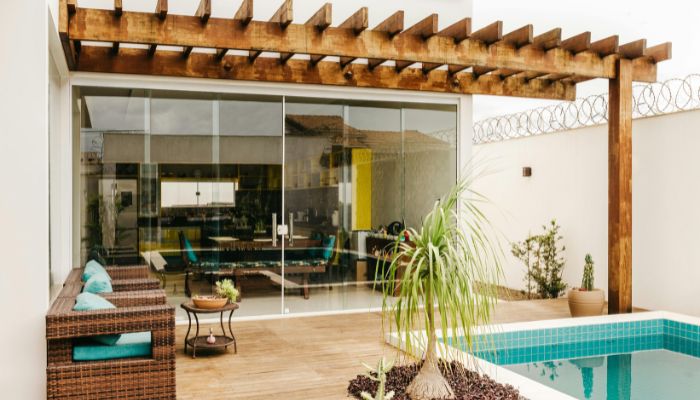Patio drainage issues can cause standing water, erosion, and structural damage if not fixed early. This guide explains how to identify, prevent, and solve common patio drainage problems with practical tips and reliable drainage solutions. Learn what causes poor drainage, how to fix a blocked drain patio, and when to call professional drainage contractors to protect your outdoor space from flooding and long-term damage.
Why Patio Drainage Problems Shouldn’t Be Ignored
Ignoring drainage issues doesn’t just cause temporary inconvenience — it can lead to long-term damage. Standing water can weaken pavers, cause soil erosion, and even lead to water seeping into your home’s foundation. Mold and mildew can also develop, creating safety and health hazards.
Fixing these issues early not only preserves your patio’s structure but also prevents costly repairs later. The key lies in identifying the type of drainage problem you’re dealing with before deciding on the right fix.
Common Causes of Patio Drainage Issues
There are several reasons why patios develop drainage problems. Understanding them is the first step toward finding the right drainage solution:
-
Improper slope – If your patio isn’t sloped correctly, water has nowhere to go.
-
Clogged drains – Leaves, debris, and dirt can block your drainage system, leading to pooling water.
-
Compact soil – Over time, soil compaction reduces water absorption, increasing runoff.
-
Insufficient drain design – Some patios lack an adequate drain patio layout, which prevents proper water flow.
In most cases, working with experienced drainage contractors can ensure that your patio gets the right grading, layout, and installation to handle heavy rainfall effectively.
Signs You Have a Patio Drainage Problem
You don’t need to wait for flooding to know something’s wrong. Look for these warning signs:
-
Water pooling on the surface after light rain
-
Erosion around patio edges or foundation
-
Algae, moss, or slippery buildup on tiles
-
Water stains on nearby walls or furniture
-
Cracking or sinking pavers
If you’re noticing any of these symptoms, it’s time to inspect your drainage setup. Sometimes, a simple cleaning can help, but in other cases, you may need a complete redesign of your drainage system.
Easy DIY Fixes for Minor Patio Drainage Problems
For small issues, a few DIY drainage solutions can go a long way in improving flow and preventing standing water:
-
Clear the existing drain – Check for blockages and debris buildup. If necessary, use a plumber’s snake or hose flush to clean the drain line.
-
Install gravel channels – Create a narrow trench filled with gravel to help redirect surface water.
-
Add more slope – You can relevel pavers or add sand underneath to increase the slope slightly.
-
Improve soil aeration – Aerating the surrounding soil helps water absorb naturally instead of pooling.
However, if water still collects after these fixes, it may indicate a deeper issue beneath the surface.
Effective Professional Drainage Solutions
When DIY methods aren’t enough, consider more permanent drainage solutions that can transform your patio’s performance. Here are a few of the most effective ones:
A. French Drains
A French drain is a perforated pipe installed underground, surrounded by gravel. It redirects water away from your patio efficiently. It’s ideal for areas that regularly experience standing water or heavy rainfall.
B. Channel Drains
Channel drains (also called trench drains) are narrow drains installed at the surface, often along the edge of patios or driveways. They collect and channel water quickly before it spreads.
C. Dry Wells
If your property has limited space, a dry well can store and disperse water underground. It’s an eco-friendly solution that keeps water off your patio while recharging the groundwater naturally.
D. Regrading the Surface
If poor slope is the main issue, regrading the patio surface ensures that water flows away rather than settling. It’s one of the most effective long-term fixes for improperly designed patios.
How to Maintain Your Patio Drainage System
Even the best drainage system needs routine care. Regular maintenance keeps it performing effectively and prevents blockages that could cause flooding later. Follow these steps:
-
Inspect drains after storms – Remove debris like leaves and mud buildup.
-
Flush the system – Rinse drains with water every few months to prevent sediment accumulation.
-
Check slopes annually – Make sure your patio surface hasn’t shifted or settled unevenly.
-
Seal paver joints – This prevents water seepage beneath pavers and reduces erosion.
For recurring clogs or slow water flow, consider reading this helpful guide on how to fix blocked drainage pipe. It provides simple, step-by-step solutions for keeping your drains clear year-round.
Tips to Preventing Future Patio Drainage Problems
Once your drainage issues are resolved, taking preventive action will save you from facing the same problem again. Here’s what you can do:
-
Design smartly from the start – Plan your drain patio with enough slope and drainage outlets.
-
Use permeable materials – Pavers and stones that allow water to pass through reduce runoff.
-
Install a gutter system – Redirecting roof water away from the patio prevents overload.
-
Regular cleaning – Keep gutters, downspouts, and drains free of debris year-round.
Preventive maintenance ensures that your drainage solution lasts and your patio remains dry and safe.
Final Thoughts
Solving patio drainage issues isn’t just about convenience — it’s about protecting your home, foundation, and outdoor space from long-term damage. Whether it’s a simple cleaning job or a full drainage redesign, taking action early is always worth it.
By understanding the causes, implementing the right drainage solution, and maintaining your system regularly, you can keep your patio dry and functional through every season.
Don’t let poor drainage ruin your outdoor enjoyment — start fixing it today and enjoy a cleaner, safer, and more comfortable patio year-round.
